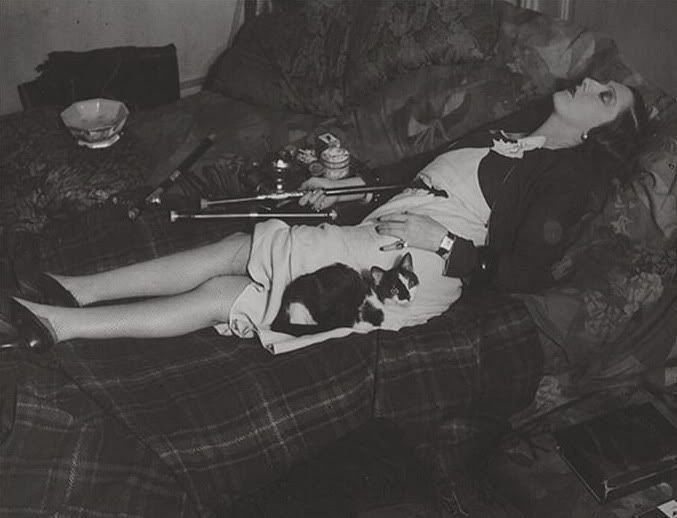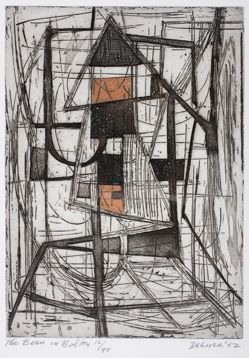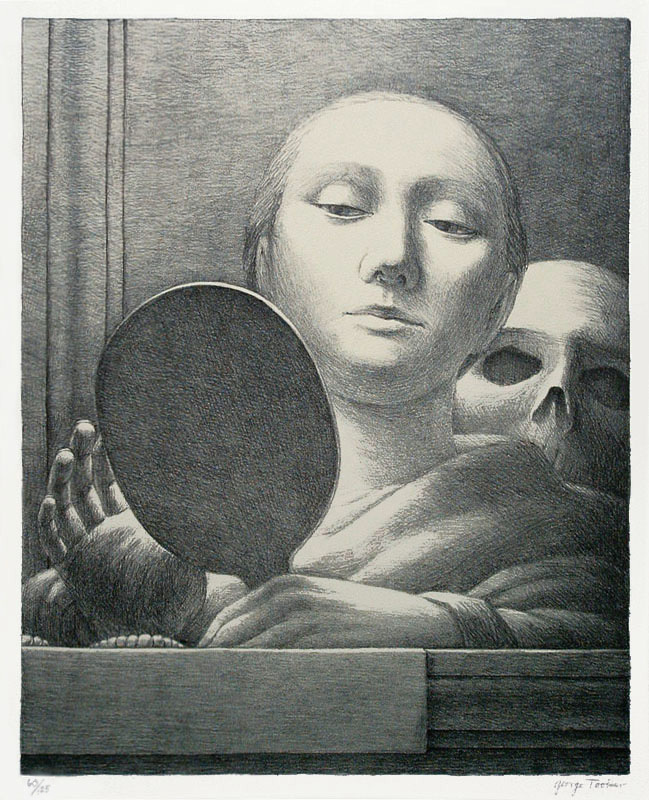(Click on the all of the Images to make them appear larger!)
The Cafe Loup art collection is pretty amazing. In the last post I wrote about the artists who are shown at the Loup with whom I had or have a personal relationship with. This time around, I am highlighting the more famous of the bunch, most of whom are no longer producing art on account of no longer being alive. I think only one of them is still among the living.
Talking about the art at the Loup, one must start with Brassai. He is essentially the image of the Loup (notwithstanding the Loup's shadow puppet logo) and his work embodies the spirit of what the Loup achieves to be. There are about a dozen photographs of his adorning the walls of the dining room. They range from his photos of transvestites, to the cops on the beat, to portraits of Picasso and Matisse. We have a couple different photos of his on the back of our dessert menu and on the front of our wine cards. [Quick side note: Sean Lennon used to live on the block and would come in quite often. One time him and Yoko came in and I waited on them. He drew a picture of one of the girls from the Brassai photograph on the wine card. When he left, I took the drawing home. So, I now own an original Lennon drawing (of a Brassai photograph, drawn at the Loup. So meta).] I like all of the Brassai's we have in the dining room. I like his style. Being a night person, I can relate to his fascination with Paris at night, especially in the 30's. Obviously, that is why he is so famous. Pre-war Paris is just about the most romantic thing you could think of, and Brassai captured it better than anyone. My favorite piece we have by him is just above Table 12. There are a couple pictures there. One of them is of a couple on a bed in a brothel. Above that is a woman relaxing at the opium den. Whenever I have a couple of people sitting there who are being indecisive or just slow at ordering, I look up at this photograph and I am instantly calmed. The woman is so stoned, it's amazing. There's a little cat with her that is probably equally as high just from the contact buzz. Compositionally, I think there are better ones, but I just like how mellow this one is. It is truly a comforting thing when I am completely in the weeds or stressed out. The woman is essentially saying to me, "This, too, will pass."
The Cafe Loup art collection is pretty amazing. In the last post I wrote about the artists who are shown at the Loup with whom I had or have a personal relationship with. This time around, I am highlighting the more famous of the bunch, most of whom are no longer producing art on account of no longer being alive. I think only one of them is still among the living.
Talking about the art at the Loup, one must start with Brassai. He is essentially the image of the Loup (notwithstanding the Loup's shadow puppet logo) and his work embodies the spirit of what the Loup achieves to be. There are about a dozen photographs of his adorning the walls of the dining room. They range from his photos of transvestites, to the cops on the beat, to portraits of Picasso and Matisse. We have a couple different photos of his on the back of our dessert menu and on the front of our wine cards. [Quick side note: Sean Lennon used to live on the block and would come in quite often. One time him and Yoko came in and I waited on them. He drew a picture of one of the girls from the Brassai photograph on the wine card. When he left, I took the drawing home. So, I now own an original Lennon drawing (of a Brassai photograph, drawn at the Loup. So meta).] I like all of the Brassai's we have in the dining room. I like his style. Being a night person, I can relate to his fascination with Paris at night, especially in the 30's. Obviously, that is why he is so famous. Pre-war Paris is just about the most romantic thing you could think of, and Brassai captured it better than anyone. My favorite piece we have by him is just above Table 12. There are a couple pictures there. One of them is of a couple on a bed in a brothel. Above that is a woman relaxing at the opium den. Whenever I have a couple of people sitting there who are being indecisive or just slow at ordering, I look up at this photograph and I am instantly calmed. The woman is so stoned, it's amazing. There's a little cat with her that is probably equally as high just from the contact buzz. Compositionally, I think there are better ones, but I just like how mellow this one is. It is truly a comforting thing when I am completely in the weeds or stressed out. The woman is essentially saying to me, "This, too, will pass."
Brassai
The most famous picture we have at the Loup is this next one, by the late Irving Penn. It is prominently displayed between Table 10 and Table 11 right up front. This is a great picture. It's called "Doug" and it is a portrait of the then leader of the Hell's Angels. I really love this piece and I look at it a lot. When you are surrounded by art all the time, sometimes you overlook it or take it for granted and it becomes part of the background. This one never does that. The steely gaze of this Doug character is so arresting, it commands attention. That, and dude's hair is epic. Penn did a shoot for Look magazine in 1967 photographing the hippies and Hell's Angel's of San Francisco's burgeoning hippie scene. He shot The Grateful Dead that day as well. His description is probably better than anything I could write about it, so here it is:
"During the photographing the hippies and the rock groups surprised me with their degree of concentration. Their eyes remained riveted on the camera lens; they were patient and gentle. The distracted quality which I feared would be typical of this new kind of person was not a problem at all.
The Angels were something else again. They were like coiled springs ready to fly loose and make trouble. Being inside a building with their precious bikes (and the wives and children I had asked them to bring) frustrated their natural tendency to smash up the place and do mischief. The delays and provocations were endless. Still, the hypnotic lens of the camera and the confinement of the studio held them in check long enough for the pictures to be made. When the experience was over and their screaming bikes went down the road, I breathed [the] deepest sigh."
Irving Penn "Doug" 1967
The next piece was bought by Lloyd himself, which is a little different, since most of the collection was bought by the previous owners, Bruce and Roxanne Bethany. As long as I have worked at the Loup, the front alcove has been adorned with a bulletin board where artists can pin up their gallery opening invitations. There are a lot of them on there from way back (I noticed one yesterday from April 2000!). But, on the board, right up front is a poster for the opening of an exhibit by the artist Eugene Von Bruenchenhein. This guy was an "outsider" artist and was never famous in his life time. He was a baker from Milwakee, Wisconsin. When he was done baking for the day, he and his wife/muse Marie would make art. Photo shoots, drawings, paintings, and essentially installations were constructed and executed. When he died, thousands of pieces were left behind, including thousands of these pin-up style portraits of his wife Marie. On the poster on the bulletin board, poor Marie's breasts have been poked though by a decades worth of push-pins, but she remains cheerfully staring out at all of coming and going guests. A couple years ago, Lloyd finally bought one of these photographs after being obsessed with them (and the poster) for years. I couldn't find the exact one that hangs in the restaurant, but the one below seems to be from the same time period/photo shoot. To see the actual piece, you'll have to come in sometime and sit up front at Table 11. It's proudly placed right beside the Penn. Lloyd was so happy when he brought it in and showed it to me for the first time. He was grinning from ear to ear and as he hung it on the wall he said to me , "Not bad for a baker's wife, eh, Junior?"
Eugene Von Bruenchenhein
This next piece is by the only living artist in this post. It is a print by the Irish artist John Kindness. Besides having an awesome last name, this guy's print is pretty sweet. It hangs in the back, by Table 36, so it has a soft spot in my heart. When I was new at the Loup, the back section was always mine. It is the easiest section, on some levels, so all the new people start out back there. I was back there for a couple years, and I got to know this picture pretty well. It's pretty simple; just a rubber ducky and the ducky's interior bone structure. Pretty simple, but that is what I like about it. We serve a delicious duck dish at the restaurant, so I think it's fitting that this little fellow commands the back corner. In fact, there is a little shrine dedicated to ducks in that back corner. There is a duck pull toy, and depending on the day, there is even a little duck toy that looks just like the one depicted in the picture. It may have been stolen though. That happens sometimes. Anyway, this guy lived in New York for a while in the 90's, so I bet that's when the Bethany's picked this one up. I could be wrong though. It is certainly the most playful of all the art at the Loup.
John Kindness
"Cocteau In Bed With Mask, Paris 1927" by Berenice Abbott hangs above Table 18. This is one of Abbott's early works, before she moved to Greenwich Village in 1935. She is most known for her work once she moved to New York. However, when she was living in Paris, she became famous, and her portraiture was a veritable "Who's Who" of the Parisian art scene. She had moved there in the 20's and started working with Man Ray. She must have known Brassai as they were working side by side at the time, and both in Paris. In this portrait, the artist, playwright, writer, and overall eccentric Jean Cocteau is seen "sleeping" with a mask. I've always liked this piece, as it is surreal without being over the top. I don't know what Cocteau's hands look like, and I have always imagined these hands to be someone else's. I am not sure if that is true, but they certainly look like they could belong to another person; a woman, perhaps? Anyway, I am also fascinated by the fact that she would have him "sleeping" like this, since he was such an active artist and socialite. Maybe it is because he never slept, and so it was funny to them to portray him in this manner. At any rate, it's an interesting piece even though at first glance it seems so simple. Another fun tidbit; this Cocteau character looks a lot like our handsome bar tender, Jay Milite! They could be cousins! Check out the similarities next time you are in on a Friday or Saturday evening.
Berenice Abbott
Dorothy Dehner's print hangs over Table 5 on the column right in front of the bar. She was an artist who lived in New York from the late twenties until her death in the 1994. She was mainly a sculptor, but she studied printmaking with Stanley William Hayter at Atlier 17. He was working on a technique he called "simultaneous color printing" which is what we see here, even though Dehner uses color sparingly. I studied printmaking in college and have given this piece the old college critique plenty of times. What stood out to me initially was the dirty edges. That was always such a sore subject in my classes that it was burned into my head to always, always, clean the edges of the plate before running it through the press. However, Dorothy never learned that lesson, or if she did, she ignored it and printed it with some filthy edges. Using the "simultaneous color printing" method, she inked up this plate (probably copper) with black ink into the grooves that she had etched, and then rolled on the red to the raised surface of the plate and then ran it through the press. This poor piece gets moved around a lot. It is on the blind side of the column, so when people come in and sit down at Table 5 with a bulky coat or backpack, the piece gets jostled. There are even marks on the wall that show the history of the constant movement, which is a bit of a shame since this woman has work hanging in MoMA.
Dorothy Dehner
Finally, we have "Mirror" by George Tooker. Another print in this same edition has a home in the Smithsonian, but you can see it just down the street at the Loup! Tooker was an American artist living in New York during the second half of the 20th century. He was well respected in his time as an artist and had shows (and work in the collections of ) MoMA, the Whitney and other prominent institutions. This lithograph hangs above Table 43 in the back of the restaurant. Unless you are sitting at Position 3, the print goes largely unnoticed, even though it is right there on the wall. I think this is because how the banquette at Table 43 is positioned. It's too bad that it's not more noticeable, although I like this place for this piece. It's a nice reminder of ones mortality while taking orders from a table of 25.
George Tooker "Mirror" 1978
The Cafe Loup has so much more art, and shows so many more artists than just these that I have mentioned. One of these days, I will find The List and give you more of a glimpse into the extensive collection at the Loup. I mean, I didn't even get into the sculptures. I guess I will leave that for another time. Until then, make sure you come down and visit. We'll have Jay Milite mix us up a couple grapefruit margaritas and we'll talk art!








No comments:
Post a Comment